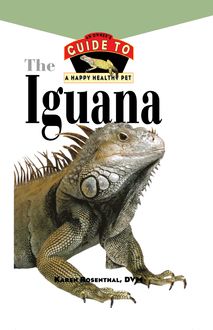Iguana , livre ebook
82
pages
English
Ebooks
2007
Vous pourrez modifier la taille du texte de cet ouvrage
Obtenez un accès à la bibliothèque pour le consulter en ligne En savoir plus
Découvre YouScribe en t'inscrivant gratuitement
Découvre YouScribe en t'inscrivant gratuitement
82
pages
English
Ebooks
2007
Vous pourrez modifier la taille du texte de cet ouvrage
Obtenez un accès à la bibliothèque pour le consulter en ligne En savoir plus
Publié par
Date de parution
20 août 2007
Nombre de lectures
1
EAN13
9780470252727
Langue
English
Poids de l'ouvrage
3 Mo
PART ONE: Welcome to the World of the Iguana.
1. What Is an Iguana?
2. The World According to the Iguana.
3. Choosing Your Iguana.
PART TWO: Living with an Iguana.
4. Bringing Your Iguana Home.
5. Feeding Your Iguana.
6. Grooming Your Iguana.
7. Your Iguana's Health.
8. Handling Your Iguana.
9. Iguanas in the World.
PART THREE: Beyond the Basics.
10. Complete Listing of Iguanas.
11. Glossary of Iguana Terms.
12. Resources.
Publié par
Date de parution
20 août 2007
Nombre de lectures
1
EAN13
9780470252727
Langue
English
Poids de l'ouvrage
3 Mo
The
Iguana
Howell Book House
Howell Book House A Simon Schuster Macmillan Company 1633 Broadway New York, NY 10019
Copyright © 1996 by Howell Book House All rights reserved. No part of this book may be reproduced or transmitted in any form or by any means, electronic or mechanical, including photocopying, recording, or by any information storage and retrieval system, without permission in writing from the Publisher.
MACMILLAN is a registered trademark of Macmillan, Inc.
Library of Congress Cataloging-in-Publication Data Rosenthal. Karen. The iguana : an owner’s guide to a happy healthy pet / by Karen Rosenthal. p. cm. ISBN 0-87605-478-5 1. Iguanas as pets. I. Title. SF459.I38R67 1996 639.3’95—dc20 96-20450 CIP
Manufactured in the United States of America 10 9 8 7
Series Director: Dominique De Vito Series Assistant Director: Ariel Cannon Book Design: Michele Laseau Cover Design: Iris Jeromnimon Illustration: Jeff Yesh
front cover, top: Scott McKiernan/Zuma Press bottom: Mary Bloom
Joan Balzarini: 68, 105
Davis Barber: 9, 34. 57, 104, 106
Mary Bloom: 6, 73
Paulette Braun/ Pets by Paulette: 18, 28, 33,56,97
Anthony Delprete: 40–41, 72, 96, 98, 101, 102, 103
Bob Klein: 22
Scott McKiernan/Zuma Press: 11, 30
Michael Siino: 10, 17, 48, 70, 76, 80
Jerry Williams: 5, 7, 8, 12, 15, 19, 24, 25, 27, 31, 35, 36, 38, 12, 43,45, 46,47, 50, 51, 54, 60, 61, 62, 63, 65, 66, 69, 77, 81, 82, 85, 88, 99, 100, 108
Production Team: Trudy Brown, Jama Carter, Kathleen Caulfield, Trudy Coler, Amy DeAngelis, Pete Fornatale, Matt Hannafin, Kathy Iwasaki, Kevin J. MacDonald, Vic Peterson, Terri Sheehan, Marvin Van Tiem.
Contents
part one
Welcome to the World of the Iguana
1 What Is an Iguana?
2 The World According to the Iguana
3 Choosing Your Iguana
part two
Living with an Iguana
4 Bringing Your Iguana Home
5 Feeding Your Iguana
6 Grooming Your Iguana
7 Your Iguana’s Health
8 Handling Your Iguana
9 Iguanas in the World
part three
Beyond the Basics
10 Complete Listing of Iguanas
11 Glossary of Iguana Terms
12 Bibliography
part one
External Features of the Iguana
chapter 1
What Is an Iguana?
The very first thing to realize is that the iguana we are the most familiar with as a pet and the one to which most of this book is dedicated is just one of many species of iguana. Scientifically, it’s known as Iguana iguana; commonly, it’s called the green iguana; familiarly, it’s the iguana. Most of the time in this book, when we refer to iguana, we mean the green iguana of pet fame. When we use the term iguana to mean the grouping of lizards called iguana, we’ll point that out.
Body Type
Iguana lizards range in habitats from arboreal (tree-dwelling) to semiarboreal. Most iguanas have tails that grow from two to three times their actual body length.
The iguana is “cold blooded” (technically it is an ectotherm), meaning its system cannot generate sufficient body heat to sustain itself. It is dependent on outside heat sources to raise its body temperature, which is why it’s critical to have the correct environment for an iguana.
Iguanas hatch from eggs (a single clutch may contain as many as sixty eggs). The female lays the eggs deep in a hole that she digs in the ground. The average length of a newborn iguana is about seven inches long. Within a year, it potentially can grow to be about a foot-and-a-half in length. Listed below are some distinguishing body features of the green iguana:
Femoral Pores On the underside of each back leg, iguanas have a single row of small, circular holes called femoral pores. Usually, the femoral pores of males are significantly larger and more pronounced than those of females. These pores produce a waxy substance that helps the male iguana mark his territory. In most green iguanas, the size of these pores can be used to distinguish males from females.
This head shot of a beautiful mature male green iguana shows the subtympanic scales below the tympanum, the round eye and part of the crest .
Subtympanic Scales Below the eardrum (tympanum) of all green iguanas there are one to three greatly enlarged scales.
Parietal Eye Iguanas have a parietal eye. It is located between the eyes, but a little further toward the back of the head. It does not look so much like a third eye as it does a large gray scale. The parietal eye is sensitive to light cycles, probably aiding in the breeding cycles.
You can see the parietal eye on this mature male iguana. It’s the red spot between the two bulges in the middle of the top of the head .
Tongue Iguanas have a short, thick tongue and will attempt to taste or lick a great many things—including their owners! It is normal for the very tip of the tongue to appear to be more red in color than the rest of the tongue.
Teeth An iguana’s tooth is round at the root and has ridges on it like a serrated edge. The teeth are described as pleurodont , which means that they actually protrude from the jawbone rather than grow from sockets above the jawbone like human teeth.
Crest Both males and females have a row of large pointy scales located down the length of the spine and tail. These scales stand up and retract, and tend to be larger on males than females. When trying to impress females and when fighting with other animals over territory, males will do everything they can to make the crest more pronounced, thus appearing bigger to their opponents.
Dewlap The iguana has a large, hanging fold of skin under its throat called a dewlap. This is expanded and displayed in courtship or in battle. Again, in males they tend to be larger than in females. During mating, females also display their dewlaps.
Color and Size
Individual green iguanas exhibit a variety of shades and colors, depending on what part of Central or South America the iguana originally came from. For example, iguanas from Brazil tend to be more blue, whereas those from El Salvador are a more vivid green, and Mexican iguanas may even be orange. Striped coloring has been noted on iguanas from Guatemala and other Central American countries. Regardless of their original color and pattern, as iguanas age, the colors fade and become more subtle.
Environment
Typically, we think of the green iguana’s natural habitat as a tropical environment of lush vegetation and fresh water. But some green iguanas live in more desertlike surroundings and some live near saltwater. Green iguanas are found in areas where temperatures reach 80 to 100 (or even higher) degrees Fahrenheit during the day and drop to 70 degrees Fahrenheit at night.
Iguanas do have teeth! They use them to chew, of course, and bite. Iguanas use also their tongues a lot to taste and lick things .
A day spent with an iguana in Costa Rica, for example, would include feasting on the surrounding vegetation, climbing up trees and vines, basking in a sunny spot, retreating to the shade, feasting on more vegetation, more basking and shading, making its way to a pool or stream for a drink and possibly a swim, a few more nibbles and then a night of sleep. Iguanas are climbers, swimmers, leaf eaters and sunbathers.
How the Iguana Got Its Name
“Iguana” is the interpretation Spanish explorers gave to the name the native American Caribbean Indians called these lizards, which was iwana . The word iguana was first used by paleontologists to describe a fossil of a prehistoric lizard they found in 1825; they called it an Iguanadon. This was what separated the iguana from other lizards.
This iguana, photographed in Costa Rica, is doing what iguanas love to do: climbing and basking among the lush vegetation in its natural habitat .
All iguanas are included in the family Iguanidae, which contains eight genera, or kinds, of iguanas. These genera include Amblyrhynchus, Brachyhphus, Conolophus, Ctenosaura, Cyclura, Dipsosaurus, Iguana and Sauromalus .
Each of the eight genera includes many species of iguana. Listed below are the more popular varieties of iguana—the ones you can find at your pet store, breeder or zoo. A more complete listing of all the types of iguanids can be found in Chapter 10 , “Complete Listing of Iguanas.”
Green Iguana (Iguana iguana) This is the most commonly kept house pet in the Iguanid family. Although it is most correct to call this animal the green iguana, many people just call it iguana, incorrectly thinking that this is the only lizard called an iguana. And, unless specifically identified in this book, when the word iguana is used, it is meant to identify the green iguana.
This species is not in any danger and in fact is enjoying its most prolific period of growth in its history. This iguana is native to Central and South America, ranging all the way from northern Mexico to parts of Paraguay. Iguanas have also been found on islands in the lesser Antilles. Recently, iguanas have been introduced to some parts of the United States, most notably to areas with similar environments (tropical climates with lots of moisture and foliage), such as south Florida.
Of all the iguanas, green iguanas are the most arboreal and were at one time known as “tree iguanas.” They are vegetarian reptiles throughout their entire life. Iguanas have been known to eat more than fifty different types of plants, but they prefer to eat the leaves of the types of vegetation found in their environment. As is true of many other reptiles, the iguana is a strong swimmer. Some have been recorded spending a half-hour under water before coming up for air.
This picture shows why green iguanas are called green iguanas! These are healthy, vibrant, youngsters .
A healthy green iguana, given the room to roam and grow, may get to be six to seven feet in length (two thirds of which is tail) and weigh up to twenty-five to thirty pounds. If you allow them to, they will dominate your house. The most important thing to remember with an iguana in regards to its needs is that it is a tropical to semitropical animal, w














